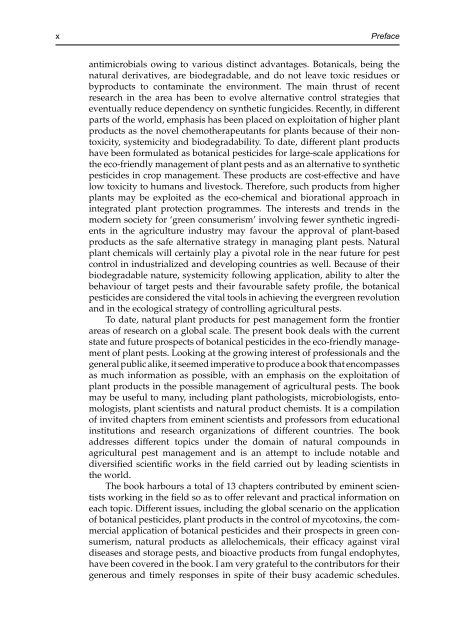natural-products-in-plant-pest-management
natural-products-in-plant-pest-management
natural-products-in-plant-pest-management
Create successful ePaper yourself
Turn your PDF publications into a flip-book with our unique Google optimized e-Paper software.
xPrefaceantimicrobials ow<strong>in</strong>g to various dist<strong>in</strong>ct advantages. Botanicals, be<strong>in</strong>g the<strong>natural</strong> derivatives, are biodegradable, and do not leave toxic residues orby<strong>products</strong> to contam<strong>in</strong>ate the environment. The ma<strong>in</strong> thrust of recentresearch <strong>in</strong> the area has been to evolve alternative control strategies thateventually reduce dependency on synthetic fungicides. Recently, <strong>in</strong> differentparts of the world, emphasis has been placed on exploitation of higher <strong>plant</strong><strong>products</strong> as the novel chemotherapeutants for <strong>plant</strong>s because of their nontoxicity,systemicity and biodegradability. To date, different <strong>plant</strong> <strong>products</strong>have been formulated as botanical <strong>pest</strong>icides for large-scale applications forthe eco-friendly <strong>management</strong> of <strong>plant</strong> <strong>pest</strong>s and as an alternative to synthetic<strong>pest</strong>icides <strong>in</strong> crop <strong>management</strong>. These <strong>products</strong> are cost-effective and havelow toxicity to humans and livestock. Therefore, such <strong>products</strong> from higher<strong>plant</strong>s may be exploited as the eco-chemical and biorational approach <strong>in</strong><strong>in</strong>tegrated <strong>plant</strong> protection programmes. The <strong>in</strong>terests and trends <strong>in</strong> themodern society for ‘green consumerism’ <strong>in</strong>volv<strong>in</strong>g fewer synthetic <strong>in</strong>gredients<strong>in</strong> the agriculture <strong>in</strong>dustry may favour the approval of <strong>plant</strong>-based<strong>products</strong> as the safe alternative strategy <strong>in</strong> manag<strong>in</strong>g <strong>plant</strong> <strong>pest</strong>s. Natural<strong>plant</strong> chemicals will certa<strong>in</strong>ly play a pivotal role <strong>in</strong> the near future for <strong>pest</strong>control <strong>in</strong> <strong>in</strong>dustrialized and develop<strong>in</strong>g countries as well. Because of theirbiodegradable nature, systemicity follow<strong>in</strong>g application, ability to alter thebehaviour of target <strong>pest</strong>s and their favourable safety profile, the botanical<strong>pest</strong>icides are considered the vital tools <strong>in</strong> achiev<strong>in</strong>g the evergreen revolutionand <strong>in</strong> the ecological strategy of controll<strong>in</strong>g agricultural <strong>pest</strong>s.To date, <strong>natural</strong> <strong>plant</strong> <strong>products</strong> for <strong>pest</strong> <strong>management</strong> form the frontierareas of research on a global scale. The present book deals with the currentstate and future prospects of botanical <strong>pest</strong>icides <strong>in</strong> the eco-friendly <strong>management</strong>of <strong>plant</strong> <strong>pest</strong>s. Look<strong>in</strong>g at the grow<strong>in</strong>g <strong>in</strong>terest of professionals and thegeneral public alike, it seemed imperative to produce a book that encompassesas much <strong>in</strong>formation as possible, with an emphasis on the exploitation of<strong>plant</strong> <strong>products</strong> <strong>in</strong> the possible <strong>management</strong> of agricultural <strong>pest</strong>s. The bookmay be useful to many, <strong>in</strong>clud<strong>in</strong>g <strong>plant</strong> pathologists, microbiologists, entomologists,<strong>plant</strong> scientists and <strong>natural</strong> product chemists. It is a compilationof <strong>in</strong>vited chapters from em<strong>in</strong>ent scientists and professors from educational<strong>in</strong>stitutions and research organizations of different countries. The bookaddresses different topics under the doma<strong>in</strong> of <strong>natural</strong> compounds <strong>in</strong>agricultural <strong>pest</strong> <strong>management</strong> and is an attempt to <strong>in</strong>clude notable anddiversified scientific works <strong>in</strong> the field carried out by lead<strong>in</strong>g scientists <strong>in</strong>the world.The book harbours a total of 13 chapters contributed by em<strong>in</strong>ent scientistswork<strong>in</strong>g <strong>in</strong> the field so as to offer relevant and practical <strong>in</strong>formation oneach topic. Different issues, <strong>in</strong>clud<strong>in</strong>g the global scenario on the applicationof botanical <strong>pest</strong>icides, <strong>plant</strong> <strong>products</strong> <strong>in</strong> the control of mycotox<strong>in</strong>s, the commercialapplication of botanical <strong>pest</strong>icides and their prospects <strong>in</strong> green consumerism,<strong>natural</strong> <strong>products</strong> as allelochemicals, their efficacy aga<strong>in</strong>st viraldiseases and storage <strong>pest</strong>s, and bioactive <strong>products</strong> from fungal endophytes,have been covered <strong>in</strong> the book. I am very grateful to the contributors for theirgenerous and timely responses <strong>in</strong> spite of their busy academic schedules.


